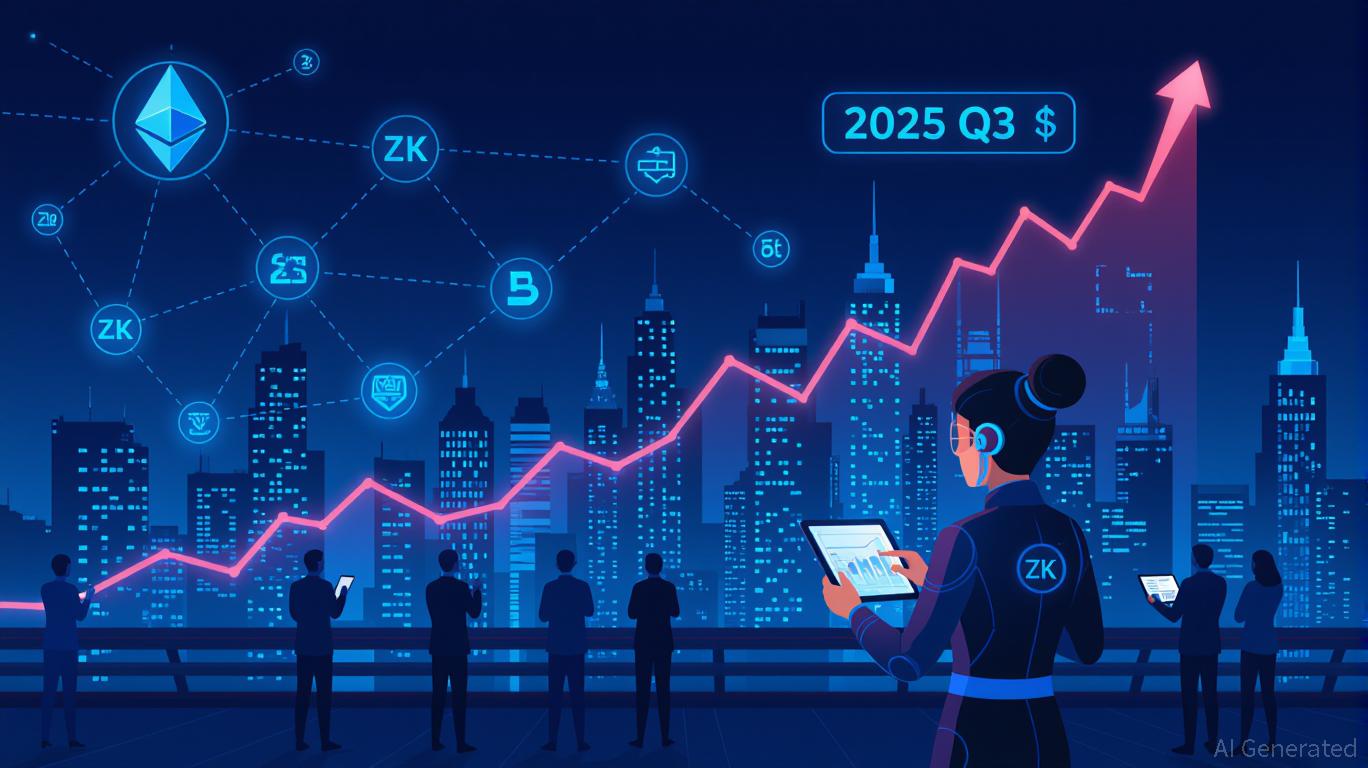Vitalik Buterin Introduces New ZK Technology: What It Means for Ethereum's Development
- Vitalik Buterin leads Ethereum’s shift to ZK proofs, targeting modexp removal and GKR protocol integration to boost scalability and privacy. - Modexp precompile’s 50x computational burden on ZK-EVM proofs will be replaced by standard EVM code, prioritizing long-term efficiency over short-term gas costs. - GKR protocol enables 2M Poseidon2 hashes/sec on consumer hardware, accelerating verification and enhancing quantum resistance for Ethereum’s "Lean Ethereum" vision. - ZKsync’s 150% token surge and Citib
Ethereum has consistently evolved by embracing new technological trends. In 2025, co-founder Vitalik Buterin is leading a major transition toward zero-knowledge (ZK) proof systems, with new proposals aimed at updating Ethereum’s core code to enhance both scalability and privacy. These updates, such as eliminating the modexp precompile and implementing the GKR protocol, are significantly impacting the investment outlook for Layer-2 networks and privacy-oriented digital assets.
The Modexp Precompile: An Outdated Constraint
Buterin has pointed out that the modexp precompile—a legacy tool for modular exponentiation in RSA encryption—has become a significant barrier to
Initially introduced for cryptographic tasks like RSA, the modexp precompile now serves only a tiny portion of users (about 0.01%), as
GKR Protocol: Advancing ZK Performance
Alongside the modexp update, Buterin’s GKR protocol introduces a cutting-edge proof system that speeds up transaction validation while maintaining privacy. According to a
The GKR protocol is central to Ethereum’s “Lean Ethereum” initiative, which focuses on efficiency, speed, and security. By reducing the resources needed for on-chain verification, GKR enables near-instant transaction finality and encourages greater institutional participation. For instance, Citibank and Mastercard have already adopted ZKsync’s Prividium platform for privacy-first infrastructure, indicating a move toward enterprise-level blockchain solutions, as reported by Bitget.
Market Impact: ZK-Fueled Expansion and Enterprise Interest
Interest in ZK-powered assets is rapidly

Another major factor is the rise of institutional involvement. The Ethereum Foundation’s “Ethereum for Institutions” initiative, led by Igor Barinov, is speeding up the adoption of privacy technologies like ZK proofs and homomorphic encryption, as covered by Yahoo Finance. These initiatives aim to balance regulatory requirements with secure, programmable financial systems, making Ethereum increasingly appealing to large organizations.
Investment Outlook: Weighing Opportunities and Challenges
Despite these technical breakthroughs, investors should consider possible downsides. Removing the modexp precompile may initially raise gas costs for older applications, but Buterin maintains this is essential for future efficiency, as CryptoNews reported. The long-term success of ZK projects also depends on how well they integrate with the broader ecosystem and the practical use of their tokens. For example, ZKsync’s move to a revenue-linked utility token creates a positive feedback loop, increasing its investment potential, according to Bitget.
Financial analysts recommend evaluating ZK assets based on three main criteria:
1. Technical Innovation: Projects actively developing new protocols like GKR and alternatives to modexp.
2. Ecosystem Connectivity: Collaborations with major institutions and Layer-2 platforms.
3. Token Utility: Models that drive value through network participation and growth.
Conclusion
Vitalik Buterin’s ZK initiatives are charting a new course for Ethereum, establishing it as a frontrunner in scalable and privacy-focused blockchain technology. Investors should pay close attention to projects that harness these advancements—such as
Disclaimer: The content of this article solely reflects the author's opinion and does not represent the platform in any capacity. This article is not intended to serve as a reference for making investment decisions.
You may also like
Kyo Achieves $1 Billion Valuation: Wagering on Cross-Chain DeFi Integration During Industry Upheaval
- Kyo Finance secures $5M Series A at $1B valuation, aiming to unify blockchain liquidity via cross-chain interoperability. - DeFi faces innovation vs. security tensions as projects like Mutuum advance infrastructure while crises like Stream Finance's $93M loss expose systemic risks. - Industry responds with risk mitigation tools (e.g., RedStone ratings) and modular infrastructure reforms to address contagion risks from interconnected lending markets. - Kyo's valuation reflects institutional confidence in
Bitcoin News Today: Trump Media Utilizes $1.3 Billion in Bitcoin as Collateral, Driving Further Growth in Cryptocurrency
- Trump Media holds $1.3B in Bitcoin as strategic reserve, using it for collateral and liquidity amid Q3 2025’s $54.8M net loss. - Loss driven by legal costs, non-cash adjustments, and crypto investments, but $10.1M operating cash flow highlights financial resilience. - Partnership with Crypto.com deepens crypto integration, including CRO treasury firm and Truth Predict prediction markets. - Plans to expand Truth Social with AI features and America-First ETFs aim to leverage crypto growth despite regulator
ALGO Climbs 13.23% Over the Past Week Despite Varied Earnings Results and Ongoing Operational Hurdles
- ALGO rose 13.23% in 7 days but fell 45.77% annually, showing mixed short-term and long-term trends. - A $31.5M loss by unrelated Aligos Therapeutics and weak equity earnings may have driven capital into ALGO. - ALGO's low volatility (only 5+5% moves in 1 year) contrasts with its recent sharp 7-day gain. - A backtest analyzing ALGO's performance after equity earnings misses could validate its potential as a contrarian hedge asset.
BCH -1.23% Experiences Decline from Temporary Pressures Despite Conflicting Fundamentals
- Bitcoin Cash (BCH) fell 1.23% in 24 hours to $504.4 amid mixed short-term and long-term price trends. - A $487.00 breakout with strong volume signaled bullish momentum, though $495.00 resistance remains critical for further gains. - Traders are testing a backtesting strategy using key support/resistance levels to evaluate breakout reliability and risk/reward potential. - Analysts highlight 7.0% daily volatility as a high-risk environment, with $487.00 support crucial to maintaining the bullish case.